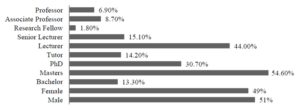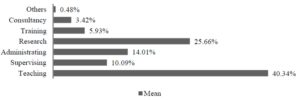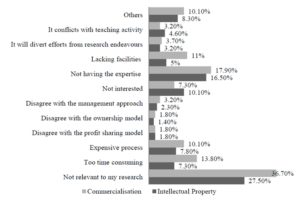Introduction
Globally, the importance of universities and their research activities have been widely recognised (Candell & Jaffe 1999). Universities in general are critical components of national systems of innovation. Being one of the major contributors to the generation and transmission of knowledge within the systems, universities are hubs of discovery and creativity. Ideas can be shared and discussed in an open and tolerant environment. They are also centres of excellence where industries can come to for their R&D needs. Universities house expertise in a variety of fields, foster relationships with stakeholders of the regions they locate within, conduct research and training, providing the foundations for a nation’s social, cultural, economic and technological progress.
Andersson (2010) identified the key factors that impacts the quality of research in universities are the research environment and researchers dynamics. This paper intends to investigate the researchers’ dynamics specifically; to explore the researchers’ profile in terms of their research achievement (over the past five years), attributes, behaviour and attitude.
Literature Review
According to Damon (2011), “From a standpoint of social policy, colleges and universities should strive to enhance welfare by producing an educated citizenry, a qualified and motivated workforce, and a continuing stream of creative ideas and conceptual breakthroughs in terms of medical technology, scientific advancement, reconsideration of appropriate roles for social institutions, reinterpretations of literature and history, and potential methods of resolving differences peacefully. Universities, collectively, should provide upward mobility for the population, providing opportunities for the disadvantaged to share in the production and consumption of the nation’s wealth. Individually, universities must deliver on the promise to provide the basis for ‘the examined life’ and, possibly, to enhance the student’s lifetime income by more than the cost of the education.”
The World Bank (2000) recognised that universities play important roles in improving the lives of individuals and society, enabling higher wages and productivity, ultimately driving society’s independence and initiative. James (1990) identified five goals for universities;
• Driving research and keep teaching loads low
• Balancing the quantity of undergraduate and postgraduate students
• Recruiting better quality students
• Balancing class size and provision of teaching support services to maintain quality
• Balancing both teaching and research quality.
Massy (1996) noted that universities in their effort for prestige and recognition have become more independent, entrepreneurial and place more emphasis on research. Andersson (2010) identified the key factors that impact the quality of research in universities, which are the research environment and researchers’ dynamics.
Damon (2011) defined “research” as, “the time the scholar spends in contemplation. The scholar’s time is an input to the production process, but contemplation may be seen as the research process itself. We also find the term “research” being used to refer to a paper written by a scholar. This is an output of the production process. It is appropriate to distinguish among: (a) spending time on research (an input), (b) conducting study or organising one’s thoughts (the process), and (c) communicating the results of the study.”
The OECD (1994) defined “research” as, “creative work undertaken on a systematic basis in order to increase the stock of knowledge, including knowledge of man, culture and society, and the use of this stock of knowledge to devise new applications.” March (1991) differentiates research between exploring new potentials and exploiting known findings. World Bank (2000) described “research universities” as, “Institutions that aim at achieving research excellence across many fields and providing high-quality education. Hence, they allocate relatively light faculty teaching loads, emphasise research accomplishments in recruitment and promotion decisions, adopt international standards for awarding degrees, and being highly selective in the students they admit. They are most closely connected to advances in knowledge, monitoring break-through in many fields and investigating ways to exploit important results for social and private gain.”
Lamari and Jacob (2011) studied factors associated with research productivity and found that variables such as age, gender, provincial government funding, federal research agency funding, and international collaboration all have significant effect on researchers productivity. Roca, Bikfalvi, Simon and Alcoba (2011) recognised the following as factors that may affect research performance;
• Government’s policies
• Universities objectives and procedures
• The unit or department the researcher belongs to
• The researcher’s own preferences and attitudes
• The research topic
• The research type; qualitative and quantitative
• Incentive systems
In the Tenth Malaysian Plan, commercialisation and innovation development has been assigned as ‘Niche 1’ by the Malaysian Ministry of Higher Education which implies the emphasis and urgency (MOHE 2010). When commercialising a university’s research, there are three main strategies commonly applied; patenting or licensing, contract research, and the creation of university spinout (USOs) companies (Kroll & Liefner 2008). The importance of academic research can be seen through spin-off creation (Clayman & Holbrook 2004; Hindle & Yencken 2004). Not only that, the importance of university research has caught the attention of the industry players. They are now relying heavily on the university research results (Fabrizio 2006). Their observation seems to be supported by earlier studies carried out both in the UK and the US (UNICO 2001; AUTM 2002).
USOs also had been identified as an effective vehicle for technology transfer (Roberts & Malone 1996; Bekkers, Gilsing, van der Steen 2006), and as an important tool for commercialisation for university research (Wright et. al. 2007). Furthermore, several studies indicate that the formation of USO companies is a more successful route to commercialisation than licensing (Gregory & Sheahe 1991; Bray & Lee 2000; Rogers, Takegami & Yin 2001).
Breznitz, O’Shea and Allen (2008) found that Massachusetts Institute of Technology’s (MIT) success was partly due to access to regional infrastructure by fostering a culture of entrepreneurship into campus; meanwhile Yale University’s success was due to the provision of infrastructure internally. A number of studies have identified several key initiatives implemented by universities towards enhancing their success rates in commercialising their research outputs and creating USOs. The initiatives include technology incubators, science and technology parks, subsidy programs, entrepreneurship centres, creating specialised offices – technology licensing office, commercialisation office, etc; incentive structures, royalty regimes, and equity investments (Mian 1997; Henrekson & Rosenberg 2001; Jensen & Thursby 2001; Feldman et al., 2002; Shane 2002, 2004; Siegel et al., 2003; Link & Scott 2005; Lockett & Wright 2005; Powers & McDougal 2005; Rasmussen et al., 2006).
A number of studies investigate the aspects of technology transfer and commercialisation by universities, such as studies by Reimers (1999), AUCC (2001), Tornatzky, et al., (2002), Lambert (2003), Miles and Daniels (2007), and Smilor and Matthews (2004). However, most of the studies come from developed nations. A developing country like Malaysia is still behind in terms of its research capabilities as evidenced by various rankings. Based on the global analysis (De Vol et al., 2006), Malaysia has no record among the top 50 university rankings worldwide. In fact, Malaysia has just entered the commercialisation game very recently. This is evidenced by the fact that the Ministry of Higher Education’s focus in terms of driving R&D activities among the universities had evolved from establishment of a research culture (2006 – 2008), to driving quality research (2008 – 2010), and most recently to promote research excellence through producing innovation and its commercialisation (2011 – 2012).
The Malaysian Landscape
The Ministry of Higher Education (MOHE) reported the research commercialisation achievement by the Malaysian public universities up till August 2008 (Table 1), which is the most current report available at the time of this study. According to the report, the 16 public universities in Malaysia had only managed to commercialise 58 products out of the 313 identified with commercial potential (who identified them). The achievements among the private universities were found to be no better than what was seen from the public ones. It was clear that there is a need to address the situation and drive the universities to a better performance level.
At the individual Institutes of Higher Learning (IHL)/university level commonly the ecosystem for R&D and business creation would include the following:
• Infrastructure and info structure for R&D activities (e.g.: library, databases, laboratories, equipment, etc.)
• Organisational structure
o R&D Management (e.g.: Research Management Centre)
o Commercialisation Management (e.g.: Business Unit, Commercialisation Centre, Technology Licensing Office (TLO), Innovation Centre, Technology Transfer Office (TTO), Training and Consulting Unit, Business Creation Office, Incubator, etc.)
• Human capital
• Policies (e.g.: R, D & C Roadmap, training and development programmes, incentives, KPIs, funding, etc.)
Table 1: University Research Commercialisation until August 2008
(Source: MOHE)

There are a number of funds, grants and incentives made available by the government to enable innovation and business creation among the universities. Figure 1 shows some examples of the government initiatives. It was reported that under the 9th Malaysia Plan (2006 – 2010), the Malaysian government invested a total of RM3.101 billion in the form of R&D grants. Meanwhile, under the 10th Malaysia Plan (2011 – 2015), the government allocated RM741 million for R&D among the universities for the first two years of the five years plan. The allocation was to be managed by the Ministry of Higher Education. In line with the new directives, the ministry announced a set of four R&D schemes to utilise the RM741 million allocations (Table 2).
There are three new aspects of the schemes, namely, the Exploratory Research Grant Scheme (ERGS), Long-term Research Grant Scheme (LRGS) and Prototype Research Grant Scheme (PRGS). Previously the Ministry only had one R&D grant scheme, the Fundamental Research Grant Scheme (FRGS). The introduction of ERGS, LRGS and PRGS, reflects the government’s desire to enhance the research, development and commercialisation activities among the universities. The three new schemes bridge the gap between university R&D activities and the programmes in placed to drive commercialisation and business creation.
Table 2: 10th Malaysia Plan Ministry of Higher Education R&D Schemes
(Source: MOHE)

In terms of the development of commercialisation efforts in the Malaysian higher education sector, the trend had been: I) establishment of private universities, II) establishment of consultancy centres, III) emphasising research – identification of research agenda, creation of “Research University” and “Apex University” status for the public universities and the establishment of research management centres, and IV) emphasising research commercialisation – this was seen more from government agenda, e.g.: the RM 191.5 billion budget announced for 2010 with the aim to create an economy based on innovation, where university R, D & C is one of the key success factors.
Methodology
The paper started with literature review and document search to answer the research objectives. The target respondents were the academicians from the public and private universities in Malaysia. Data was collected using a self-administered questionnaire developed for this study. Based on the sampling frame of 500 academicians from the public and private universities in Malaysia, 218 samples were obtained revealing a 43.6% response rate. The survey was developed to explore the researchers’ behaviour and attitude with regards to research, development and commercialisation activities. Firstly, their research achievements for the past five years were determined in terms of conducting research, producing intellectual properties and commercialised output. The researchers were then profiled further in terms of their attitude, time management, and behaviour. The survey also captured the researchers’ opinion on aspects related to research, development and commercialisation activities from their universities. The survey also investigates the common reasons for not conducting research, producing intellectual properties and commercialised output. The data collection period was throughout the months of January, February and March, 2011.
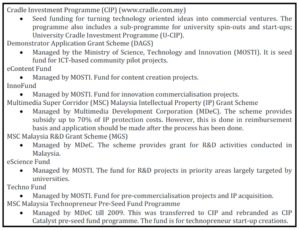
Figure 1: Government Financial Programmes
Findings
Out of the 218 respondents from 13 different institutions, 49.1% are female and 50.9% are male, with academic qualifications ranging from Bachelor (13.3%), Masters (54.6%), PhD (30.7%) and others (1.4%). The positions ranging from tutor (14.2%), lecturer (44%), senior lecturer (15.1%), research fellow (1.8%), associate professor (8.7%) to professor (6.9%) and others (9.2%).
Figure 2: Demographic
Researchers’ Profile
Out of the 218 respondents, 71.5% reported to have conducted research work within the past five years. 23.8% reported to have conducted research work and the output had led to intellectual property rights filing within the past five years. Furthermore, 13.3% reported to have conducted research work and the output had been commercialised within the past five years. This distribution of research indicates that almost three-quarters of the surveyed respondents involved in research work within 2006 to 2010 while one-quarter did not. Out of those three-quarter active researchers, less than half of their research output had led to Intellectual Property Right (IPR) filing. The proportion of research output that had been commercialised was only one-third of those active researchers. This suggests that there’s a decreasing trend as they move along the research, development and commercialisation spectrum. This reflects the evolution of the focus areas from the Malaysian government for the higher education sector. (Figure 3) Written work such as policy briefs, books, journal papers etc, are the most common output, followed by outputs produced by graduate students (PhD, Masters, etc), IP, commercialisation and others. (See Figure 4)
 Figure 3: Research achievements for the past five years (2006 – 2010)
Figure 3: Research achievements for the past five years (2006 – 2010)
 Figure 4: Number of output for the past five years (2006 – 2010)
Figure 4: Number of output for the past five years (2006 – 2010)
Almost half of the researchers (48.6%) have industry experience. It is common that academics have to juggle research with teaching and administrative works. 53.7% of the respondents teach undergraduate programs only, 2.8% teach postgraduate programs only, and 29.4% teach both levels. 69.7% of the respondents hold administrative positions at various levels, 17.4% serves on national academic/professional bodies, 10.1% serve on international bodies and 2.3% serve both at national and international levels. 47.2% of the respondents normally conduct one research project only at any one time, 33% have a portfolio of research projects, and 14.7% normally do not have any research projects. The profile is shown in Figure 5 to 8.
Researchers’ Attitude towards Research, Development and Commercialisation Activities
Sixteen statements were used to capture the respondents’ attitude relating to research, development and commercialisation activities. The respondents were asked to rate the statements on a Likert-scaled (1 = Totally Disagree, 2 = Somewhat Disagree, 3 = Somewhat Agree, 4 = Totally Agree). Figure 9 shows the mean bar chart of each statement relating to the researchers’ attitude. Table 3 indicates the codes used to label the statements. Based on the mean distribution, four statements were rated among the highest that include the respondents’ preference to collaborate in research, and they also felt that they needed more training and experience to turn their research into commercial value, and also to become a good researcher. In addition to that, they expressed that they did research because it was important to the university. It is important to note that there is a preference towards teaching. Career advancement, personal goals and university’s interest also contribute towards the importance of research. In terms of guiding their research areas, own interest tends to be more important than commercial value or career advancement considerations.
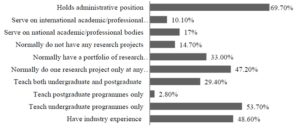
Figure 5: The Profile (Administrative, teaching and experience)
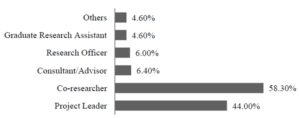
Figure 6: Roles in Research Projects
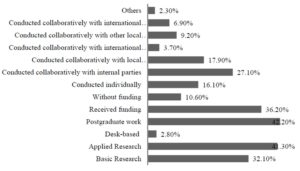
Figure 7: Types of Research Projects

Figure 8: Funding for the Research Projects
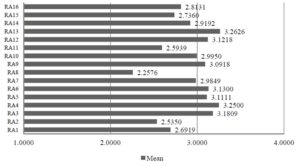
Figure 9: Means of Researchers’ Attitude
Table 3: Statements relating to Researchers’ Attitude
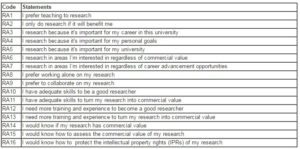
Researchers’ Time Management and Allocation
Six statements were also asked to the respondents in order to capture their time management and allocation. They were required to rate the six statements using the Likert-scaled (1 = Totally Disagree, 2 = Somewhat Disagree, 3 = Somewhat Agree, 4 = Totally Agree). The respondents were also asked to indicate their allocation of time spent on these common activities such as teaching, supervising, research, administrative, training, consultancy and others. The following figures 10 and 11 summarise the researchers’ time management and allocation. Spending more time on teaching than research received a highest mean, but fell within somewhat disagree to somewhat agree. This is closely followed by making sure to make time for research. Generally, the respondents were tied up with administrative work and teaching, but tried to balance them with research. This scenario is reflected in the time allocation given among the main activities of the academics. Teaching on average received the biggest time allocation and research second. However, if the other activities are combined, research ends up being the activity with the smallest allocation of time.

Figure 10: Researchers’ Time Management
Figure 11: Researchers’ Time Allocation
Researchers’ Behaviour relating to Aspects that Influence Their Research
Six Likert-scaled (0 = Not available, 1 = Never, 2 = Rarely, 3 = Often, 4 = Always) statements were used to capture the respondents’ behaviour relating to aspects that influence their research, development and commercialisation activities. Figure 12 shows the mean bar chart of the overall sample, those that do research, intellectual property filing from research output, and commercialisation of the research output within the past five years. Utilising the research facilities provided by the university is the most common behaviour among the respondents and receiving financial incentives is the least. In general, there is an increasing trend as we move from the overall group to those that do research, to those that file for IP and finally to those that commercialise their research output.
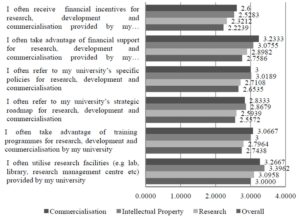
Figure 12: Researchers’ Behaviour
Another six Likert-scaled (0 = not available, 1 = Totally Disagree, 2 = Somewhat Disagree, 3 = Somewhat Agree, 4 = Totally Agree) statements were used to capture the respondents’ opinion on how much of the same aspects actually drive the research and commercialisation activities in the university. The result (Figure 13) shows that the researchers feel that the supports for driving commercialisation activities were lagging when compared to those designed for driving research activities.
The correlations of the researchers’ opinions about their universities and their behavior (overall) were examined (Table 4). Following were observed from the results. All the correlations that are found significant are positive. There are significant correlations between the researchers’ opinion about the university’s facilities, training programs, strategic roadmap, policies, financial support and incentives helping to drive the research activities with them actually utilising the facilities, training programs and financial supports, referring to the strategic roadmap and policies, and receiving financial incentives. Exception is seen between their opinions regarding the training programs with them actually utilising the financial supports.
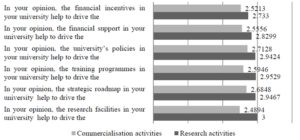
Figure 13: Researchers’ Opinion – University
Furthermore, there are also significant correlations between the researchers’ opinion about the university’s facilities, training programs, strategic roadmap, policies, financial support and incentives helping to drive the commercialisation activities with them actually utilising the facilities, training programs and financial supports, referring to the strategic roadmap and policies, and receiving financial incentives. Exceptions are seen between their opinions regarding the strategic roadmap, training programs, policies and financial incentives with them actually utilising the facilities. Similar to earlier, exception is seen between their opinions regarding the training programs driving the commercialisation activities with them actually utilising the financial supports.
Table 4: Correlations between Researchers’ Opinion about University and Researchers’ Behaviour
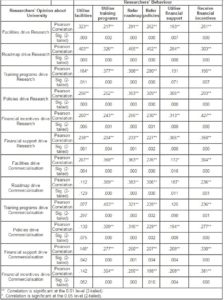
Reasons for Not Conducting Research for the Past Five Years (2006 – 2010)
The respondents that answered “No” to having conducted research over the past five years cited a number of reasons as shown in Figure 14. The most common reason for not being an active researcher was due to not having the time to do research. The other common reasons include lacking training to do research and having too much teaching responsibilities prevented them from pursuing research. This reflects their average time allocation (Figure 11).
Reasons for Not Having Research Output that Led to IPR Filing and Commercialisation in the Past Five Years (2006 – 2010)
The respondents that answered “No” chose the reasons as shown in Figure 15. The most common reason for not having research output that led to IPR filing and commercialisation was due to believing that such activities have no relevance to their research work. The other top reasons include lacking the necessary expertise, simply not interested to do so, as well as the view that such activities are too time consuming as well as expensive.
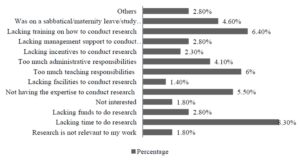
Figure 14: Reasons for Not Conducting Research for the Past Five Years (2006 – 2010)
Figure 15: Reasons for Not Having Research Output that Led to IPR Filing and Commercialisation in the Past Five Years (2006 – 2010)
Conclusions
The growth of a developing country such as Malaysia into a developed nation status must be by focusing on driving the local capacity for innovation. The HEIs play the lead role here. Thus, insights to the key players are crucial towards the formulation of targeted and impactful policies.
The policy evolution in terms of driving R&D activities among the universities in Malaysia had evolved from the establishment of a research culture (2006 – 2008), to driving quality research (2008 – 2010), and most recently to promote research excellence through producing innovation and its commercialisation (2011 – 2012). The findings reflect this evolution where over 70% of the sample reported to have conducted research activities in the past five years (2006-2010). The numbers decreased significantly for IPR filing and research commercialisation.
The researchers have preference to collaborate in research, and they also felt that they needed more training and experience to turn their research into commercial value, and also to become a good researcher. It is important to note that there seems to be a preference towards teaching. Career advancement, personal goals and university’s interest all seem to contribute towards the importance of research. In terms of guiding their research areas, intrinsic interest seems to be more important than commercial value or career advancement considerations. However, they appear to be loaded with administrative work and teaching, but tried to balance them with research. Some found time to be a major obstacle to doing research.
Based on the results, this study suggests there is a need to improve the knowledge and skills of the researchers. Sufficient and comprehensive training related to research and commercialisation must be given to the researchers to increase their performance. Evidently, the study reveals that the researchers are more comfortable to work in a team. This indicates that being in a team may create a sense comfort which comes from the opportunity to develop their skills and better contribute to their team and research output.
Utilising the research facilities provided by the university is the most common behaviour among the respondents and receiving financial incentives is the least. The behaviour intensity seems to follow an increasing trend as we move from those that do research, to those that file for IP and finally to those that commercialise their research output. The result (Figure 13) shows that the researchers feel that the supports for driving commercialisation activities were lagging when compared to those designed for driving research activities. The analysis showed significant correlations between the researchers’ opinion about the university’s facilities, training programs, strategic roadmap, policies, financial support and incentives helping to drive the commercialisation activities with them actually utilising the facilities, training programs and financial supports, referring to the strategic roadmap and policies, and receiving financial incentives. Thus, since their view about the supports for commercialisation lag those for research activities, the lower commercialisation and IPR filing achievements when compared to doing research is not surprising.
Lastly, the researchers’ belief that IPR filing and commercialisation have no relevance to their research work is a significant obstacle along with lacking the necessary expertise, interest, as well as the view that such activities are too time consuming and/or expensive. This highlights the need for more awareness and development programmes focusing on IPR filing and research commercialisation for the researchers in Malaysia.
(adsbygoogle = window.adsbygoogle || []).push({});
References
1. Andersson, T. (2010), ‘Public Research and University Reform – European Perspectives’ Discussion Paper for the Workshop on University Organisation, Excellence, and Societal Impacts, 5 August 2010, Kuala Lumpur.
2. Association of Universities and Colleges of Canada (2001), Commercialization of University Research, [Retrieved January 10, 2008], http://www.aucc.ca/_pdf/english/reports/2001/commerc_05_25_e.pdf.
3. Association of University Technology Managers (2002), ‘AUTM Licensing Survey. Northbrook, Ill: AUTM.
4. Bekkers, R., Gilsing, V., & Steen, M. (2006). Determining Factors of the Effectiveness of IP-based Spin-offs: Comparing the Netherlands and the US. The Journal of Technology Transfer, 31(5), 545–546.
Publisher – Google Scholar
5. Bray, MJ. and Lee, JN. (2000), ‘University Revenues from Technology Transfer: Licensing Fees vs. Equity Positions,’ Journal of Business Venturing, 15, (5–6): 385–392.
Publisher
6. Breznitz, SM., O‟Shea, RP. and Allen, TJ. (2008), ‘University Commercialization Strategies in the Development of Regional Bioclusters,’ Journal of Product Innovation Management, 25: 129-142.
Publisher
7. Candell, A. and Jaffe, A.B. (1999), ‘The Regional Economic Impact of Public Research Funding: A Case Study of Massachusetts, In L. M. Branscomb, F. Kodama & R. Florida’ Industrializing Knowledge. US, MIT Press: 510-530.
8. Clayman, BP. and Holbrook, JAD. (2004), ‘The Survival of University Spin-offs as a Measure of Research Funding Effectiveness, CPROST Report 04-03, [Retrieved January 10, 2010], http://www2.sfu.ca/cprost/docs/CFI%20spinoffs%20March2.doc
9. Damon, WW.(2011), ‘The Research University: Allocating Resources within Schools and among Schools’ Proceedings of the American Institute of Higher Education 6th International Conference, 6-8 April 2011, Charleston, South Carolina, 395-406.
10. DeVol, R., Bedroussian, A., Babayan, A., Frye, M., Murphy, D., Philipson, T. J., Wallace, L., Wong, P., & Yeo, B. (2006). Mind to Market : A Global Analysis of University Biotechnology Transfer and Commercialization September 2006.
11. Fabrizio, K. (2006), The use of university research in firm innovation, In: Chesbrough, H., Vanhaverbeke, W. and West, J. (eds), Open innovation; researching a new paradigm, Oxford University Press, London.
12. Feldman, M., Feller, I., Bercovitz, J. and Burton, R. (2002), ‘Equity and the Technology Transfer Strategies of American Research Universities,’ Management Science, 48(1): 105-121.
Publisher – Google Scholar
13. Gregory, WD. and Sheahen, TP. (1991), Technology transfer by spin-off companies versus licensing, In: Brett, A., Gibson, DV. and Smilor, RW. (eds), University spin-off companies, USA, Rowman & Littlefield Publishers, Inc, 133-152.
14. Henrekson, M. and Rosenberg, N. (2001), ‘Designing Efficient Institution for Science-based Entrepreneurship: Lesson from the US and Sweden,’ Journal of Technology Transfer, 26(3): 207-231.
Publisher
15. Hindle, K. and Yencken, J. (2004), ‘Public Research Commercialisation, Entrepreneurship and New Technology based Firms: an Integrated Model,’ Technovation, 24(10): 793–803.
Publisher – Google Scholar
16. James, E. (1990), Decisions processes and priorities in higher education, In: Hoenack, SA. and Collins, EL. (Eds.), The economics of American universities: Management, operations, and fiscal environment, State University of New York Press, Albany.
17. Jensen, R. and Thursby, M. (2001), ‘Proofs and Prototypes for Sale: The Tale of University Licensing,’ American Economic Review, 91(1): 240-259.
Publisher – Google Scholar
18. Kroll, H. and Liefner, I. (2008), ‘Spin-off Enterprises as a Means of Technology Commercialization in a Transforming Economy – Evidence from three universities in China,’ Technovation, 28: 298-313.
Publisher
19. Lamari, M. and Jacob, JL. (2011), ‘Factors Associated with Research Productivity of Education Faculty: An Econometric Analysis of the Publication Performances within Quebec Universities, 2001-2008.’ Proceedings of the EDULEARN11 Conference, 4-6 July 2011, Barcelona, 7080.
20. Lambert, R. (2003), Lambert Review of Business-University Collaboration, HMSO, [Retrieved April 20, 2010], http://www.eua.be/eua/jsp/en/upload/lambert_review_final_450.1151581102387.pdf
21. Link, AN. and Scott, JT. (2005), ‘Opening the Ivory Tower‟s Door: an Analysis of the Determinants of the Formation of U.S university Spin-off Companies,’ Research Policy, 34(7): 1106-1112.
Publisher
22. Lockett, A. and Wright, M. (2005), ‘Resources, Capabilities, Risk Capital and the Creation of University Spin-out Companies,’ Research Policy, 34(7): 1043-1057.
Publisher
23. March, JG (1991), ‘Exploration and exploitation in organizational learning,’ Organization Science, 2(1): 71-87.
Publisher – Google Scholar
24. Massy, WF. (1996), Resource allocation in higher education, Ann Arbor: University of Michigan Press.
25. OECD (1994), The Measurement of Scientific and Technological Activities, Paris: OECD.
26. Miles, N. and Daniels, R., (2007), The State of the Innovation Economy in the UK-2007: Problems, Opportunities and Solutions, [Retrieved April 20, 2011], http://o2c.elektomi.net/controversy-corner/State%20of%20InnovEco.pdf
27. Ministry of Higher Education (2010), ‘Niche 1: commercialization and innovation development, AKEPT (Higher Education Leadership Academy) Centre for Leadership Research and Innovation, Putrajaya. [Retrieved April 18, 2010], http://www.mohe.gov.my/akept/doc/ACLRI/Niche_1.pdf
28. Powers, JB. and McDougall, PP. (2005), ‘University Start-up Formation and Technology Licensing with Firms that Go Public: a Resource-based View of Academic Entrepreneurship,’ Journal of Business Venturing, 20(3): 291-311.
Publisher – Google Scholar
29. Rasmussen, E., Moen, Ø. and Gulbrandsen, M. (2006), ‘Initiatives to Promote Commercialization of University Knowledge,’ Technovation, 26(4): 518–533.
Publisher
30. Reimers, N. (1999), Best North American Practices in Technology Transfer, Report to Expert Panel on the Commercialization of University Research of the Prime Minister‟s Advisory Council on Science and Technology, ACST, [Retrieved March 20, 2002], http://www.acst-ccst.gca.ca.
31. Roberts, EB. and Malone, DE. (1996), ‘Policies and Structures for Spinning off New Companies from Research and Development Organizations,’ R & D Management, 26(1): 17-48.
Publisher – Google Scholar
32. Roca, J., Bikfalvi, A., Simon, A. and Alcoba, O. (2011), ‘Knowledge Transfer Management as a Tool for Enhancing Research Teams Performance.’ Proceedings of the EDULEARN11 Conference, 4-6 July 2011, Barcelona, 4854-4861.
33. Rogers, EM., Takegami, S. and Yin, J. (2001), ‘Lessons learned about Technology Transfer,’ Technovation, 21(4): 253-261.
Publisher – Google Scholar
34. Shane, S. (2002), ‘University Technology Transfer to Entrepreneurial Companies,’ Journal of Business Venturing, 17(6): 537-552.
Publisher – Google Scholar
35. Shane, S. (2004), Academic Entrepreneurship: University Spin-offs and Wealth Creation, Edward Elgar, Cheltenham, UK/Northampton, MA, USA.
36. Siegel, DS., Waldman, D. and Link, AN. (2003), ‘Assessing the Impact of Organizational Practices on the Productivity of University Technology Transfer Offices: an Exploratory Study,’ Research Policy, 32(1): 27-48.
Publisher – Google Scholar
37. Smilor, R. and Matthews, J. (2004), ‘University Venturing: Technology Transfer and Commercialisation in Higher Education,’ International Journal of Technology Transfer & Commercialisation, 3(1): 111-128.
38. The University Companies Association (2001), ‘Annual Survey on University Technology Transfer Activities, NUBS.
39. Tornatzky, L., Waugaman, P. and Gray, D. (2002), Innovation U.: New University Roles in a Knowledge Economy, Southern Growth Policies Board, ISBN 0-927364-25-5.
40. World Bank, (2000), ‘Higher Education in developing Countries: Peril and Promise, The task Force on Higher Education and Society, Washington,D.C: The World Bank.
41. Wright, MB., Clarysse, P., Mustar and Lockett, A. (2007), Academic Entrepreneurship in Europe, Edward Elgar, Cheltenham.






